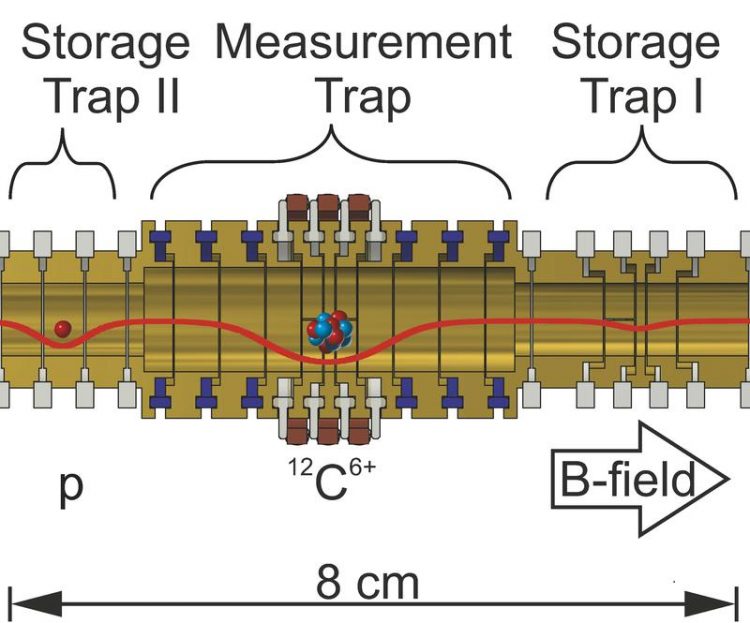The proton precisely weighted

Sketch of the Penning trap apparatus for measurement of the proton’s mass. Different voltages applied to the cylindrical electrodes (yellow) generate the trapping potential indicated by the red line.
To determine the mass of a single proton still more accurate – a group of physicists led by Klaus Blaum and Sven Sturm of the Max Planck Institute for Nuclear Physics in Heidelberg did this not only just for fun or to set a new record. The proton is the nucleus of the hydrogen atom and building block in all other atomic nuclei. Therefore, the proton’s mass is an important parameter in atomic physics: Among other things it affects how the electrons move around the atomic nucleus.
This is reflected in the spectra, i.e., the light colours (wavelengths) atoms can absorb and emit again. By comparing these wavelengths with theoretical predictions, it is possible to test fundamental physical theories. Further, a precise comparison of the masses of the proton and the antiproton may help in the search for the crucial difference – besides the reversed sign of the charge – between matter and antimatter. This difference is tiny, but it has to exist, since the Universe practically completely consists of matter, although in the Big Bang matter and antimatter must have been created in equal amounts.
Penning traps are well-proven as suitable “scales” for ions. In such a trap, it is possible to confine single charged particles such as a proton nearly forever, by means of electric and magnetic fields. Inside the trap, the snared particle performs a characteristic motion that can be described by three frequencies. These frequencies can be measured and the mass of the particle calculated therefrom. In order to reach the targeted high precision, an elaborate measurement technique was required.
The carbon isotope 12C with a mass of 12 atomic mass units is defined as the mass standard for atoms. “We directly used it for comparison”, tells Sven Sturm. “First we stored each one proton and one carbon ion (12C6+) in separate compartments of our Penning trap apparatus, then transported alternately each one of the two ions into the central measurement compartment and measured its motion.” From the ratio of the two measured values one obtains the proton’s mass directly in atomic units. The measurement compartment is equipped with specifically developed purpose-built electronics. Andreas Mooser of RIKEN in Japan explains its function: „It allowed us to measure the proton under identical conditions as the carbon ion despite its about 12-fold lower mass and 6-fold smaller charge.”
The resulting mass of the proton of 1.007276466583(15)(29) atomic mass units is three times more precise than the presently recommended value. The numbers in parentheses refer to the statistical and systematic uncertainties, respectively.
However, the new value is significantly smaller than the current standard value. Measurements by other authors yielded discrepancies with respect to the mass of the tritium atom, the heaviest hydrogen isotope (T = 3H), and the mass of light helium (3He) compared to the “semiheavy” hydrogen molecule HD (D = 2H, deuterium, heavy hydrogen). “Our result contributes to solving this puzzle, since it corrects the proton’s mass in the proper direction”, says Klaus Blaum delightedly.
Florian Köhler-Langes of MPIK explains how the researchers intend to further improve the precision of their measurement: “In the future, we will store a third ion in our trap tower. By measuring simultaneously the motion of this reference ion, we will be able to eliminate the uncertainty originating from fluctuations of the magnetic field.”
Original publication:
High-precision measurement of the proton’s atomic mass
F. Heiße, F. Köhler-Langes, S. Rau, J. Hou, S. Junck, A. Kracke, A. Mooser, W. Quint, S. Ulmer, G. Werth, K. Blaum, and S. Sturm, Physical Review Letters 119, 033001 (18 July 2017 online) https://doi.org/10.1103/PhysRevLett.119.033001
Contact:
Prof. Dr. Klaus Blaum, MPI for Nuclear Physics
E-Mail: klaus.blaum@mpi-hd.mpg.de
Tel.: +49 6221 516850
Dr. Sven Sturm, MPI for Nuclear Physics
E-Mail: sven.sturm@mpi-hd.mpg.de
Tel.: +49 6221 516447
Dr. Andreas Mooser, RIKEN
E-Mail: andreas.mooser@cern.ch
https://physics.aps.org/synopsis-for/10.1103/PhysRevLett.119.033001 – Physics Synopsis: Proton Loses Weight
https://www.mpi-hd.mpg.de/blaum/index.en.html – Division Blaum at MPIK
http://ulmerfsl.riken.jp/index.html – Ulmer Fundamental Symmetries Laboratory at RIKEN
Media Contact
All latest news from the category: Physics and Astronomy
This area deals with the fundamental laws and building blocks of nature and how they interact, the properties and the behavior of matter, and research into space and time and their structures.
innovations-report provides in-depth reports and articles on subjects such as astrophysics, laser technologies, nuclear, quantum, particle and solid-state physics, nanotechnologies, planetary research and findings (Mars, Venus) and developments related to the Hubble Telescope.
Newest articles

NASA: Mystery of life’s handedness deepens
The mystery of why life uses molecules with specific orientations has deepened with a NASA-funded discovery that RNA — a key molecule thought to have potentially held the instructions for…

What are the effects of historic lithium mining on water quality?
Study reveals low levels of common contaminants but high levels of other elements in waters associated with an abandoned lithium mine. Lithium ore and mining waste from a historic lithium…

Quantum-inspired design boosts efficiency of heat-to-electricity conversion
Rice engineers take unconventional route to improving thermophotovoltaic systems. Researchers at Rice University have found a new way to improve a key element of thermophotovoltaic (TPV) systems, which convert heat…



